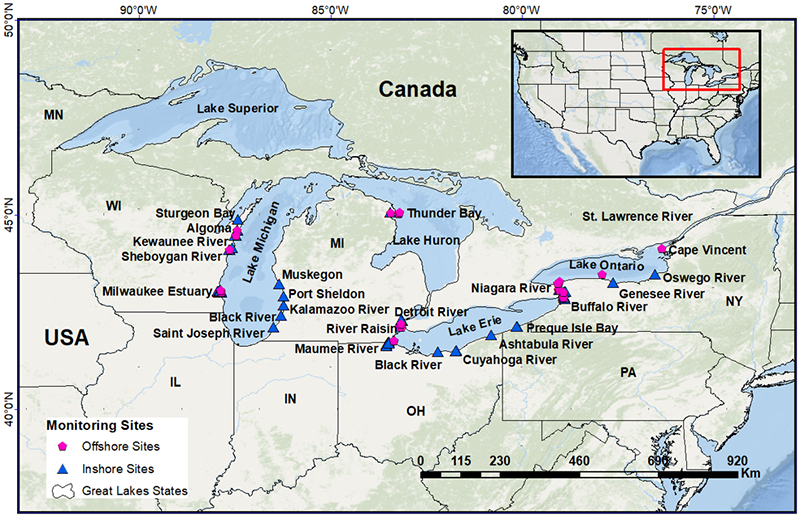NOAA’s Mussel Watch Program has monitored the nation’s coastal waters for chemical contaminants since 1986. These monitoring efforts now include contaminants of emerging concern, such as per- and polyfluoroalkyl substances (PFASs), which are found in hundreds of products, but can persist in the environment and threaten human and animal health. Since 2013, the program has been analyzing mussel samples from the Great Lakes to support a better understanding of the sources, fate, and transport of PFASs in the lakes and to fill important data gaps for local stakeholders.
Why We Care
As the largest body of freshwater on earth, the Great Lakes provide drinking water for millions of people and support multi-billion dollar fishery and recreation industries. Thousands of chemical contaminants from point and non-point (diffuse) sources accumulate in these lakes every day, compromising water quality, and, subsequently, threatening human and ecosystem health.
Previous studies in the region have investigated legacy (e.g., polychlorinated biphenyls (PCBs), organochlorine pesticides, and polycyclic aromatic hydrocarbons (PAHs); Kimbrough et al., 2014), as well as emerging contaminants, such as pharmaceuticals and personal care products (PPCPs; Kimbrough et al., 2018). These research and monitoring efforts have helped regional managers limit the impact these contaminants have on coastal ecosystems, many of which are known to be harmful to people, animals, and the environment. In response to resource managers’ and stakeholders’ concerns about emerging chemical stressors like PFASs, the Great Lakes Mussel Watch Program began a basin-wide monitoring effort to assess the magnitude and distribution of PFAS contaminants in the Great Lakes.
What We Are Doing
The Mussel Watch Program uses an ecosystem-based approach to monitoring, which entails measuring the concentration of chemical contaminants in sediment and tissue of indigenous bivalves, such as oysters and mussels, as a way to evaluate local environmental quality. Bivalves are used as indicator organisms for chemical contaminants in their local environments because they are sessile and sedentary, and they bioaccumulate contaminants in the water as they filter feed. The Mussel Watch Program currently analyzes sediment and bivalve tissue for a suite of legacy contaminants, contaminants of emerging concern (CECs), and contaminants of mutual concern (CMCs).
Legacy contaminants have been monitored within the Mussel Watch Program since 1986 and include compounds such as chlordanes, chlorobenzenes, dichlorodiphenyltrichloroethane (DDT), dieldrins, endosulfans, hexachlorocyclohexanes (HCHs), butyltins, PAHs, and PCBs. The monitoring of CECs and CMCs in the Great Lakes region began in 2009 and includes contaminants such as alkylphenols, alternative flame retardants, current-use pesticides, per- and polyfluoroalkyl substances (PFASs), polybrominated diphenyl ether (PBDEs), polybrominated biphenyls (PBBs), and pharmaceuticals and personal care products (PPCPs). In general, CECs and some CMCs are minimally regulated, not commonly monitored, but potentially toxic chemicals that are finding their way into the environment.
Starting In 2013, under the Great Lakes Restoration Initiative (GLRI), the Mussel Watch Program sampled a network of over 130 sites in the Great Lakes region for a suite of organic pollutants. Under this monitoring effort, Dreissenid mussels were collected across the major lakes (Erie, Huron, Ontario, Michigan, Superior, and St. Clair) and connecting channels (Detroit and Niagara River) following the Mussel Watch Program standard protocols. These sites were selected as a combination of long-term Great Lakes Mussel Watch Program monitoring sites and new targeted sites under the GLRI phase l and ll assessments. The sites were purposefully selected to enable the project to not only assess the magnitude and distribution of chemical stressors in the nearshore areas, but also to evaluate the environmental occurrence of these chemical stressors in EPA’s designated areas of concern and the impacts of land-use and other environmental stressors on the distribution of these contaminants in the Great Lakes.

Benefits of Our Work
Results of this project will help fill critical data gaps defined in GLRI Action Plan III (see focus area 1.3: “increase knowledge about Great Lakes Water Quality Agreement Annex 3 chemicals in the Great Lakes.”) Data from this project will support ongoing monitoring objectives on ecotoxicity of contaminants of mutual concern (CMCs) that use available bioactivity data (e.g., the USEPA ToxCast database and the ToxEval and ToxMixtures software) to prioritize contaminants and locations and their potential environmental health implications.
This study will augment and provide much-needed tissue data on the magnitude and environmental occurrence of PFASs to the National and Great Lakes Mussel Watch Program tissue database and to local stakeholders and managers in the Great Lakes region. Specifically, the Great Lakes Regional Pollution Working Group and Lake-wide Action Monitoring Programs. This project will also provide information on water quality data used by coastal resource managers to develop effective, long-term policies to protect ecosystem services provided by the Great Lakes.
